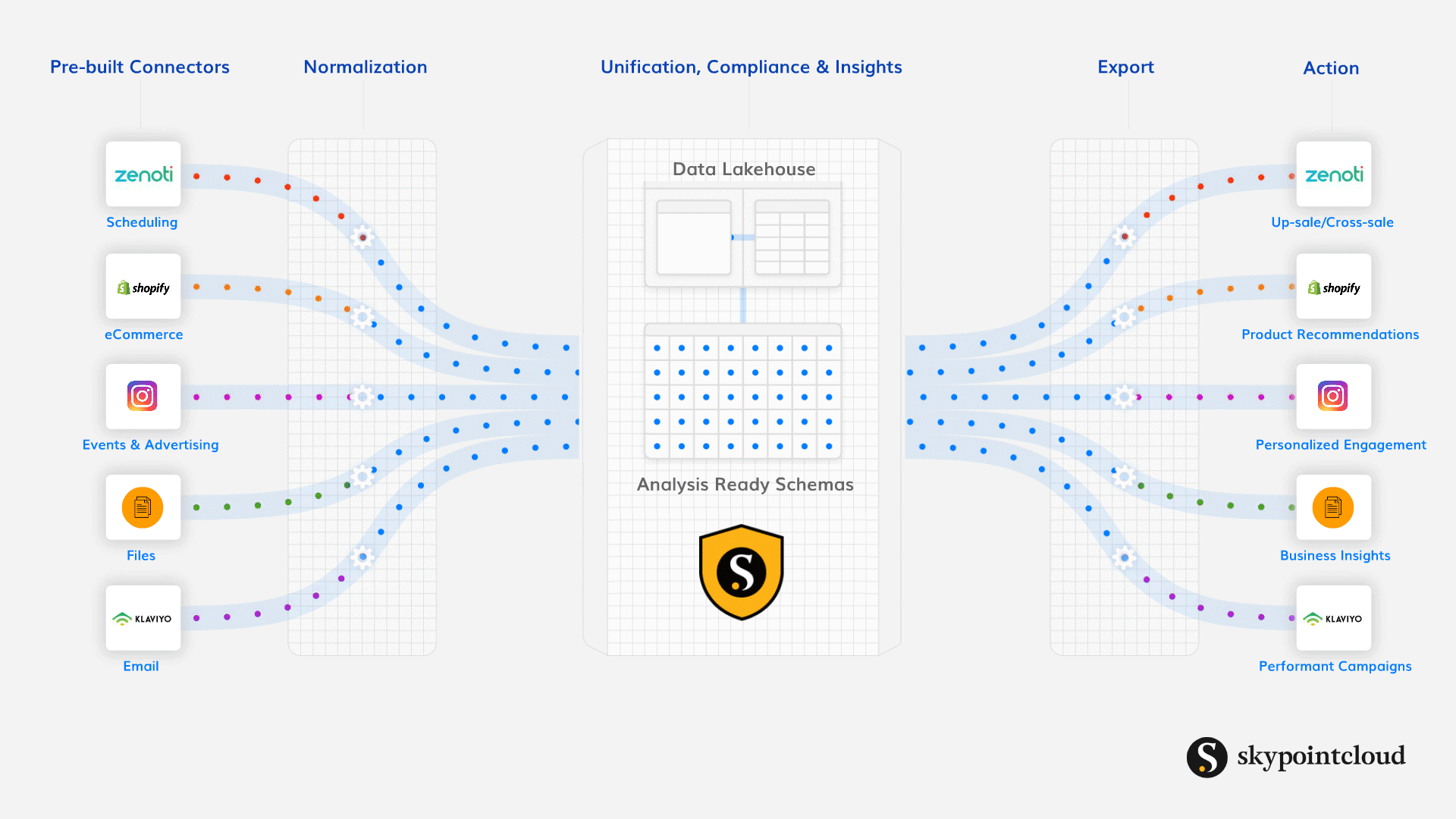

Portland Timbers and Skypoint’s CDP Redefine the Fan Experience
Recently Skypoint announced its selection as the customer data platform (CDP) for the Portland Timbers, a premier club in Major League Soccer (MLS) in the
Skypoint’s AI-powered customer data platform (CDP) is a single secure location for leveraging quality data to build effective programs and exceptional experiences.
A new era of data has arrived. Users are more in control of their experiences and brand and privacy expectations have never been higher. Unified data, analytics and insights are vital for delivering personalized experiences regardless of industry.
Using AI, Skypoint’s modernized customer data platform (CDP) creates new dimensions for understanding and segmenting your customers into high-performing audiences. This “Next-Gen CDP” approach pushes beyond the current standards of traditional CDPs, by incorporating the latest technologies and features like AI and data warehousing to meet evolving customer needs.
Our predictive models leverage unified customer data to pinpoint and mitigate potential sticking points, or capitalize on previously unseen opportunities for engagement.
Personalization continues to be a top goal for organizations. Yet, the lack of customer insights and intelligence is slowing the shift to customer-centric business models. Our CDP is built on leading-edge data lakehouse technology that meets your ever-changing data needs.
Make your data work for you by leveraging our zero-copy data lakehouse, or bring your own data warehouse. High-quality customer data unified through master data management enables valuable business intelligence and predictive analytics to simultaneously advance and simplify your efforts.
Skypoint’s CDP brings your customer data together from multiple sources to create a unified view of the customer or business. It collects first-party, second party, and third-party details. The data is then cleansed and categorized for precision into enriched B2B or B2C profiles.

Import data from disparate data sources into the Skypoint Lakehouse using Dataflow, Skypoint’s built-in ELT tool.
Create targeted audience segments using AI-powered insights and unified customer or business profiles.
Use Reverse ETL to execute targeted campaign segments leveraging third-party tools like HubSpot, Google Ads, and more.
Skypoint’s CDP focuses on core capabilities to provide a platform for B2B or B2C use cases that is both comprehensive, and flexible, while incorporating essential best practices centering around unification, governance, privacy and AI.
Skypoint’s built-in ELT, allows you to effortlessly centralize all your data, maintain privacy compliance, and deliver personalized experiences with real-time insights.
Skypoint Cloud’s master data management enables organizations to integrate, cleanse, unify and enrich their data across various sources while providing data governance.
A Data Lakehouse is the core of the CDP, combining the benefits of a data lake and data warehouse to create a new open data management architecture.
Harness the power of AI to deduplicate, manage, and improve core business entities or individuals, such as patients, providers, customers, guests, residents, products, and suppliers.
Automate data unification across silos to create unique 360-degree profiles for personalized and trusted interactions.
With a variety of options ranging from simple yes/no predictions, to bespoke machine learning models for complex scenarios – Skypoint CDP helps you make rapid decisions at scale to deliver the best possible outcomes.
A privacy-first approach to data management and accessibility ensures privacy compliance across business initiatives.
Built on Microsoft Azure, Skypoint Cloud fully aligns with Azure as a data security and trust platform that follows four core principles—security, privacy, compliance, and reliability.
Our advanced predictive models enable organizations in various industries such as retail, hospitality and healthcare to effortlessly identify potential opportunities or issues while leveraging the power of AI.
By unifying and analyzing data from CRM systems, electronic health records, and social media platforms, senior living communities can gain a comprehensive view of each resident. Create personalized experiences for residents based on their interests, preferences and behaviors – such as sending tailored invitations or notifications about upcoming events.
This unified intelligence could also help identify residents who may be at risk of leaving or dissatisfied with their experience in order to take proactive steps that ensure an improved experience for all.
Some example use cases of Skypoint’s CDP in Senior Living include:
Personalized care plans: By unifying resident data from various sources, such as electronic health records, activity trackers, and dietary preferences, senior living providers create personalized care plans for each resident.
Staff efficiency: Optimize staff schedules and staffing levels by providing real-time data on resident needs and preferences. This can help ensure that staff resources are allocated in the most effective way possible.
Resident engagement: Identify which activities and programs are most popular with residents, and which are not. This can help providers optimize their offerings to drive better resident engagement and satisfaction.
Marketing and sales: Identify potential residents who are most likely to be interested in their products, services or alternative properties. This can enable providers to target their marketing and sales efforts more effectively, resulting in higher conversion rates and more revenue.
Healthcare providers can leverage a Customer Data Platform to improve patient experiences and outcomes. By unifying available data into comprehensive profiles using master data management, healthcare organizations can then develop tailored experiences like treatments and recommendations for individual patients while streamlining communication between them and their care team.
Some example use cases of Skypoint’s CDP include:
Personalized patient care: Create personalized treatment plans for patients by unifying patient data from various sources into a comprehensive patient 360 profile. This includes electronic health records (EHRs), wearables, and patient feedback surveys.
Patient engagement and satisfaction: Create a comprehensive view of the patient and their preferences, allowing providers to communicate with patients in a more personalized and effective way.
Predictive analytics: Proactively identify patients who are at risk of developing certain conditions or who may need additional care. By analyzing patient data in real-time, healthcare providers can proactively intervene and prevent negative health outcomes.
Operational efficiency: Streamline operations by unifying data from various sources and eliminating duplicate or inaccurate data. This can help reduce administrative costs and improve overall efficiency, allowing providers to focus on patient care.
By connecting customer data from various sources including POS systems, e-commerce channels and loyalty programs, Skypoint’s CDP helps both retail and hospitality organizations create more personalized marketing strategies that can lead to improved engagement with customers and guests.
Send targeted reminders and product recommendations based on abandoned online carts, create segmented marketing campaigns with personalized services that are informed by customer behavior both in-store and online. This integration helps build an all-encompassing view of customer engagement – allowing businesses to improve inventory management decisions as well as optimize in-store experiences.
Other example use cases of Skypoint’s CDP in Retail include:
Unified customer view: Unify customer data from multiple sources into a single, comprehensive view of the customer, providing a complete understanding of the customer across all channels and touch points.
Data quality and accuracy: Cleanse, standardize, and enrich customer data, ensuring its accuracy and completeness.
Campaign optimization: Create targeted campaigns based on custom segments that can be created using the unified customer data. This enables organizations to optimize marketing and engagement initiatives, leading to increased engagement, loyalty, and revenue.
Analytics and reporting: Leverage a range of predictive analytics models and reporting tools, including dashboards and visualizations, to help users better understand their customers and optimize their marketing and engagement efforts.
Data Lakehouse architecture: Skypoint’s CDP is built on a data Lakehouse architecture, which combines the scalability and flexibility of a data lake with the performance and reliability of a data warehouse. This enables organizations to store and process large amounts of data at scale, while maintaining high levels of data quality and accuracy.


Recently Skypoint announced its selection as the customer data platform (CDP) for the Portland Timbers, a premier club in Major League Soccer (MLS) in the
Skypoint’s CDP, built on unified profiles, unlocks powerful AI and business intelligence possibilities. This enables your organization to rapidly visualize and make proactive business decisions based on carefully curated data points.
All the components of an CDP solution— ingestion, modeling, governance, lineage, tracking and visualization – work seamlessly together to support your ongoing success. Built on a centralized Data Lakehouse.
Learn how The Portland Timbers used a CDP to rapidly segment email lists from disparate data sources and generate $250,000 in new sales from just one email campaign.
A customer data platform creates a unified customer profile with information gathered from multiple sources. CDPs collect data on anonymous visitors to your website and analyze lifetime customer behavior and customer journeys, tracking both online and offline customer data. They’re designed to handle multiple data points from a large number of sources.
Skypoint’s CDP is built with integrated privacy compliance and sensitive data management. We use a proprietary identity resolution model to stitch your first-party customer data together to create a comprehensive customer profile and journey.
We allow customers to configure role-based access to PII and other data that is labeled sensitive by our customers to ensure usability while protecting consumer privacy
Skypoint Cloud normalizes and standardizes customer data leveraging the Common Data Model (CDM). CDM is an open standard that creates an extensible collection of data schemas (entities, attributes, relationships) that translate into business concepts and activities.
The Skypoint platform maps your customer data to CDM to power our proprietary identity resolution model which stitches data together to create a comprehensive profile of customer activities, interactions, transactions, and behaviors.
With a growing list of native connectors, you can easily and quickly connect your data from existing systems directly into Skypoint’s platform. Our integrations list is always expanding.
Customer data platform (CDP) and master data management (MDM) are both data management technologies, but they serve different purposes. MDM is focused on creating a single source of truth for critical business data, while CDP is focused on creating a unified view of customer data to support customer interactions and experiences. MDM is typically used for back-office functions, while CDP is used for customer-facing activities.
Here’s a brief summary of what makes CDP different from MDM:
Aspect | Master Data Management (MDM) | Customer Data Platform (CDP) |
Goal | Creating a “single source of truth” for business data | Consolidating and unifying customer data from multiple sources |
Data Sources | Structured data from internal systems | Structured and unstructured data from multiple sources |
Data Management | Focuses on data quality, governance, and consistency | Focuses on data processing, segmentation, and personalization |
Usage | Back-office functions (finance, supply chain, etc.) | Customer-facing activities (marketing, sales, customer service) |
Skypoint Cloud uses a series of data quality checks to identify issues and ensure only the highest quality and most complete data is included in our identity resolution model—improving the overall accuracy of our matching model.
We leverage pattern-based validations and standard regular expressions for normalizing data. Our platform also provides insights to help you continuously improve data quality and know which actions to take. Together, we are always increasing the completeness and accuracy of your data source systems.
customer 360 consolidates and organizes the information that a brand knows about its customers into comprehensive profiles. The information that these profiles contain varies from one business to another, but typically includes:
Many customer 360s include not just raw data but a view of each customer that is enriched with relevant attributes and predictions. For example, a customer 360 view for a consumer brand might include derived fields like “number of last transactions in the last 12 months” and “likelihood to purchase in the next 3 months.”
A customer 360 is a foundational tool for businesses that aims to personalize and improve the customer experience. Brands typically use their customer 360 to fuel use cases like:
Understanding of the overall customer base to design better products and experiences (What percentage of my customers have seen a primary care physician at least once over the past month?)
Measurement of customer health (Has my active customer base been trending up or down over time?)
Segmentation to identify the optimal channel, message, or promotion for groups of customers (Who are my customers who make frequent, low dollar-value purchases?)
Personalization of one-to-one customer interactions (What’s the clinical history of a particular patient engaging with a care rep on a digital health app?)
Skypoint’s CDP is here to help you connect customer data from channels and systems so you create secure and personalized brand experiences.